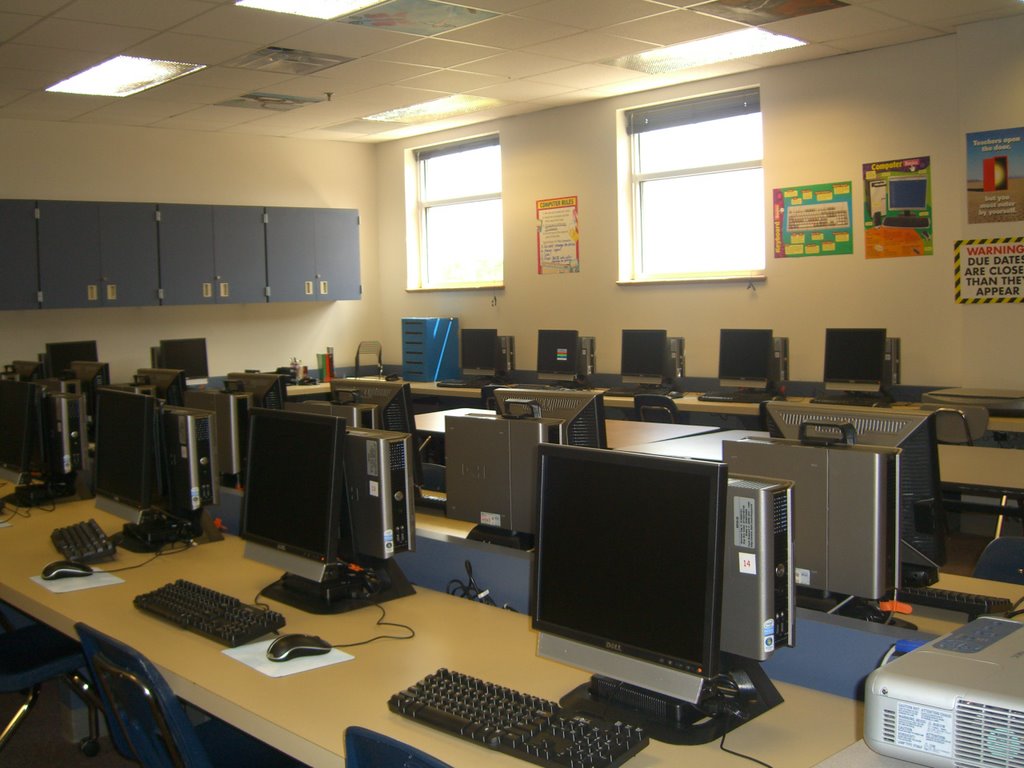“You’re all dead.”
In my twelve years of teaching, I was in more lockdown drills than fire drills and more lockdowns than school fires, yet nothing prepares you for the sight of a man with a gun walking into your classroom and uttering those words. Your heart tries to run while your brain falters in panic mode.
This was “only a drill,” but I didn’t know that.
See, our school was participating in a new kind of “active shooter lockdown drill,” where our school resource officer, a police man carrying actual weapons, would be the “active shooter.” He would see how many rooms he could gain entry to and “kill” before the school gained awareness and called for a lockdown. Since my classroom was next to the school’s back entrance and he had the keys, he started with me.
 My classroom. My 6th grade students who saw a man in black assault gear carrying an assault rifle and pointing it at them. They didn’t know if it was fake. (To this day, I don’t know if it was real or not. No one ever told me.) All they saw was a man walk in, point a weapon, and tell them they were all dead. With all of the gun violence in our country, I understand a school’s desire to practice lockdown procedure. After all, I’ve been in non-drill lockdowns often enough to see the value of practice with children. But what happened that day was terrifying and traumatizing.
My classroom. My 6th grade students who saw a man in black assault gear carrying an assault rifle and pointing it at them. They didn’t know if it was fake. (To this day, I don’t know if it was real or not. No one ever told me.) All they saw was a man walk in, point a weapon, and tell them they were all dead. With all of the gun violence in our country, I understand a school’s desire to practice lockdown procedure. After all, I’ve been in non-drill lockdowns often enough to see the value of practice with children. But what happened that day was terrifying and traumatizing.
There was no warning to me that this was a drill. Only the fact that he left without shooting us clued me into that fact.
After calling the front office to report it, my classroom didn’t follow lockdown procedure. We couldn’t. I had 28 kids—eleven-year-olds, mind you—who were crying. Kids who didn’t understand what was happening and truly thought they were going to die. One child wet himself. There was no way they would hide now. They wanted their parents. They wanted to go home. They wanted someone to hug them and tell them they weren’t going to die.
Again, this was only a drill.
 When you’re a teacher, you’re prepared to put your body on the line for your students. They don’t give us body armor or combat pay, despite the number of teachers who have died protecting their students from a shower of bullets. They don’t give us guns either, not that it would have helped. Our police officer was inside my room with his weapon already drawn before I had done more than blink.
When you’re a teacher, you’re prepared to put your body on the line for your students. They don’t give us body armor or combat pay, despite the number of teachers who have died protecting their students from a shower of bullets. They don’t give us guns either, not that it would have helped. Our police officer was inside my room with his weapon already drawn before I had done more than blink.
There was no time to draw a nonexistent weapon. No time to dive out of the way or even in front of my students to protect them. No time to be a hero, trained or not. As is the case with most school shootings, he had a plan, a weapon, and the upper-hand. I grew up with guns, but even if I had had one on me, there was no time.
To make matters worse, my sixth graders already had a healthy distrust of police officers. Being mostly Hispanic, ICE raids were the norm for families in Texas. Their teachers tried to teach them that their school resource officer was a man who could be trusted, but when he walked into my classroom and told them that they were dead, they believed him.
I waited for the outrage from parents. How dare he scare children in that manner! Life was frightening enough with school shootings being the norm without a drill of this manner, but the emails and phone calls never came. Whether it was from their distrust of the police or from the knowledge that this was the new normal, I’ll never know.
When my lunch break arrived, I spent it in tears. This was the new normal.
Whereas I had taken shelter under my desk as a child to hide from the bombs we thought Russia would drop on us, my students practiced hiding from an increasing likelihood that they might be shot by their fellow students. My students practiced how to die.
This wasn’t a singular incident either. My first year teaching I found myself in an actual lockdown without knowing it. The school used code words to announce it, only no one had told the new teachers or the substitute teachers what those words meant, so when the lockdown was called, I kept teaching, oblivious to the real danger we were in.
 An armed criminal was on the run from the police and had cut through the field near our school. When my 7th graders heard a ruckus outside, I stuck my head out of my classroom window to see what was going on. A man was running towards us, police in pursuit, and for a moment, I froze. Could he climb up to the window? Was locking the window enough to keep him out? Why weren’t we in lockdown? Oh, wait. Was that what the cryptic message had been about?
An armed criminal was on the run from the police and had cut through the field near our school. When my 7th graders heard a ruckus outside, I stuck my head out of my classroom window to see what was going on. A man was running towards us, police in pursuit, and for a moment, I froze. Could he climb up to the window? Was locking the window enough to keep him out? Why weren’t we in lockdown? Oh, wait. Was that what the cryptic message had been about?
A million questions in the blink of an eye before I flew into action. Windows closed and locked. Blinds down. Door closed and locked. Students silenced and hidden from view. Panic as we waited, all eyes on the windows.
In his rush to escape the police, had he seen my head poking out? Would he try to get into the building? Would we become a hostage situation, the breaking news of the day? Would my students become another statistic in a war they didn’t understand?
The man veered away from the school and was captured, but it didn’t keep the terror from our faculty and students. It lived inside of us as school resumed normal schedule and as students texted parents to let them know they were alive and okay.
My last year of teaching, it was reported that a student brought a weapon to school. When the announcement came for us to go into lockdown, my 8th graders and I flew into action like rescue responders after a tornado. We knew what to do and how to lay silently out of sight, we knew what objects in my classroom could be used as weapons if an intruder made it inside, and we knew how to cry.
“Is it a drill?” one of them whispered, and when I shook my head, they huddled together, holding one another. Some prayed. Some silently pleaded with me to do something, anything. Some texted on their phones when they thought I wasn’t looking—messages to parents out of fear and worry.
When it’s not a drill, the questions are fast and furious. What will I do if someone breaks down the door? What can I do if shots are fired? Should I text my husband in case I die today? If I have to die, how can I keep my students safe? How do I put on a brave face in the meantime and help my students remain calm in a situation where calm is the furthest thing from my mind?
It was a false alarm—what was thought to be a knife, ended up being a comb—but it didn’t stop those fifteen minutes from feeling like hours. It didn’t stop us from being terrorized in one of the places we should be safest. When I got home later that evening, my mother told me she was glad I was retiring from teaching.
“You could have died today,” she said.
What I didn’t say in response was that I could have died every day. Every lockdown was a reminder of our mortality, especially in a society that places gun rights before the lives of others. Every day that our country’s priorities are skewed is another day that a teacher, a student, or a coach could die.
There is no drill that prepares you for this reality.
There is no weapon that can protect you from the knowledge that your country values its guns more than its children.
And with another school shooting, there is nothing I can do to get those three words out of my head.


